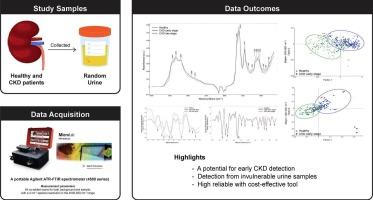衰减全反射傅里叶变换红外光谱法鉴别早期慢性肾病患者尿液红外光谱生物标志物
IF 2.9
3区 医学
Q2 MEDICAL LABORATORY TECHNOLOGY
引用次数: 0
摘要
慢性肾脏疾病(CKD)是一种非常普遍的非传染性疾病,缺乏诊断的金标准方法。早期CKD仍未得到诊断和治疗,导致疾病进展。该研究旨在使用ATR-FTIR光谱仪区分CKD患者和健康组的尿液样本。包括45个健康和100个CKD尿液样本。将3微升尿液的5个副本滴在晶体上,并在便携式ATR-FTIR光谱仪上作为薄膜风干。光谱分析采用多元分析结合机器学习。PCA评分图显示了早期和晚期CKD组在CH和指纹区与健康组的区别。为了筛选方法,将机器学习引入健康和早期CKD样本。使用六个机器学习模型生成预测模型。神经网络(NN)模型表现出最好的性能,在测试数据集上达到85 %的灵敏度,73 %的特异性和77 %的准确率。因此,ATR-FTIR数据结合机器学习显示出作为筛查CKD患者最小尿量的高性能医疗工具的潜力。本文章由计算机程序翻译,如有差异,请以英文原文为准。

Discrimination of urine infrared spectral biomarkers for early-stage chronic kidney disease patients using attenuated total reflectance fourier transform infrared spectrometry
Chronic Kidney Disease (CKD) is a highly prevalent non-communicable disorder lacking a gold standard method for diagnosis. Early-stage CKD remains undiagnosed and untreated leading to the disease progression. The study aimed to discriminate urine samples from CKD patients and healthy groups using an ATR-FTIR spectrometer. Forty-five healthy and a hundred CKD urine samples were included. Five replicates of three microliters of urine were dropped onto a crystal and air-dried as a film on a portable ATR-FTIR spectrometer. Spectra were analyzed using multivariate analysis combined with machine learning. The PCA scores plot showed the discrimination of the CKD group, both early and late stage, from healthy in the C![]() H and fingerprint regions. For a screening approach, machine learning were introduced to the healthy and early-stage CKD samples. Prediction models were generated using six machine learning models. The neural networks (NN) model demonstrating the best performance, achieving 85 % sensitivity, 73 % specificity and 77 % accuracy on test dataset. Thus, ATR-FTIR data combined with machine learning shows potential as a medical tool with high performance for screening minimal urine volumes of CKD patients.
H and fingerprint regions. For a screening approach, machine learning were introduced to the healthy and early-stage CKD samples. Prediction models were generated using six machine learning models. The neural networks (NN) model demonstrating the best performance, achieving 85 % sensitivity, 73 % specificity and 77 % accuracy on test dataset. Thus, ATR-FTIR data combined with machine learning shows potential as a medical tool with high performance for screening minimal urine volumes of CKD patients.
求助全文
通过发布文献求助,成功后即可免费获取论文全文。
去求助
来源期刊

Clinica Chimica Acta
医学-医学实验技术
CiteScore
10.10
自引率
2.00%
发文量
1268
审稿时长
23 days
期刊介绍:
The Official Journal of the International Federation of Clinical Chemistry and Laboratory Medicine (IFCC)
Clinica Chimica Acta is a high-quality journal which publishes original Research Communications in the field of clinical chemistry and laboratory medicine, defined as the diagnostic application of chemistry, biochemistry, immunochemistry, biochemical aspects of hematology, toxicology, and molecular biology to the study of human disease in body fluids and cells.
The objective of the journal is to publish novel information leading to a better understanding of biological mechanisms of human diseases, their prevention, diagnosis, and patient management. Reports of an applied clinical character are also welcome. Papers concerned with normal metabolic processes or with constituents of normal cells or body fluids, such as reports of experimental or clinical studies in animals, are only considered when they are clearly and directly relevant to human disease. Evaluation of commercial products have a low priority for publication, unless they are novel or represent a technological breakthrough. Studies dealing with effects of drugs and natural products and studies dealing with the redox status in various diseases are not within the journal''s scope. Development and evaluation of novel analytical methodologies where applicable to diagnostic clinical chemistry and laboratory medicine, including point-of-care testing, and topics on laboratory management and informatics will also be considered. Studies focused on emerging diagnostic technologies and (big) data analysis procedures including digitalization, mobile Health, and artificial Intelligence applied to Laboratory Medicine are also of interest.
 求助内容:
求助内容: 应助结果提醒方式:
应助结果提醒方式:


